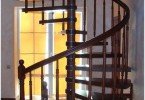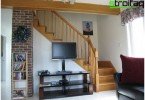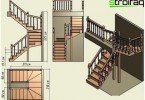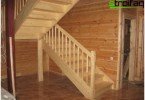Stairs to the attic
Attic is a necessary attribute of any home. A house in which there is no attic partially loses its appeal. The attic, a kind of family archive, can be used in different ways: to put seasonal things on it (like sledges in the summer and fins in the winter), arrange a warehouse from what “might come in handy someday,” equip it as a games room or workshop for the owner of the house . But, in any case, the attic must be mandatory and, therefore, a staircase should lead to it. It is traditionally believed that a real staircase to the attic should evoke a whole gamut of feelings and emotions, be associated with secrets and riddles (for this you can not remove the cobwebs from it for years), you must have creaky steps, but you can restrict yourself to simpler options.
Content
- What considerations should be used when choosing a design?
- Types of unsteady attic stairs
- Features of installation technology
What considerations should be used when choosing a design?
In general, all attic staircases are easily divided into stationary and folding various modifications: two-section folding, three-four-section sliding attic stairs, as well as stairs equipped with an electric drive.
The type of attic stairs depends on a number of factors that must be considered when choosing. The first factor is the availability of free space. If the area of the room allows, then you can install the stairs in the attic the same as other stairs in the house – from the same material, in the same style, the same size. In this case, the harmonious unity of the design and interior of the house will not be violated, which for many owners, especially owners, is a determining factor.
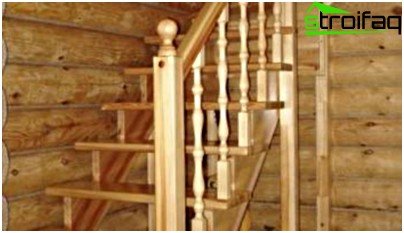
The staircase, corresponding to the overall design of the house, looks good, but it takes up a lot of space
If there is not so much free space and you want to free up space for something more important than the stairs, then you can use more affordable options, for example, install folding attic stairs. These stairs do not have such external monumentality and stability as stationary, but they are no less reliable and safe, and in some cases they are the best solution, for example, if there are small children in the house who have nothing to do in the attic for their own safety.
And immediately the next question arises – who will use the stairs most often? If these are elderly people, then the requirements for the convenience and safety of the stairs automatically increase. In addition, it should give the impression of being strong and reliable even with a superficial examination. If there are children in the house, then you should take care to limit the possibility of their unauthorized access to both the stairs and the attic, since the safety rules usually observed in the house are often involuntarily violated in those rooms that are used from time to time.
Types of unsteady attic stairs
A foldable attic staircase with your own hands is a completely feasible task, subject to the availability of certain construction and engineering skills. However, many manufacturers offer such designs in a ready-made form and their prices are quite affordable, so the choice depends on the owner of the house.
Retractable stairs to the attic have one important advantage – they absolutely do not violate the interior of the house, because they are not visible, they are hidden in the attic behind the manhole cover. This remarkable feature was immediately appreciated by designers who got rid of the problem of decorating and decorating this part of the interior of the house..
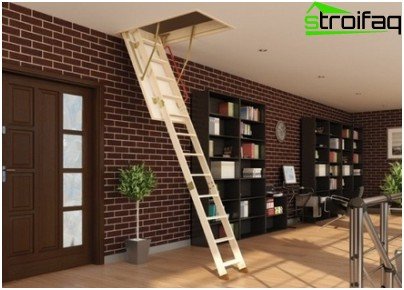
This staircase may not serve as a decoration for the room, but it will hide in the attic hatch after use.
One of the modifications of folding ladders is the sliding staircase to the attic, which makes sense to use where there is not enough space even for a compact folding one. If ordinary folding stairs consist of 3-4 sections, then the sliding one consists of only two and, therefore, is even more compact. At the same time, manufacturers claim that this does not affect its quality, strength, reliability and safety. Such stairs are ideal for giving and for those cases when there is no need for constant access to the attic.
In modern homes, an attic door is rarely used as an entrance to the attic – this is impractical from the point of view of efficient use of space. The attic hatch with a staircase fixed on it in such a way that the staircase folds up and turns out to be hidden in the ceiling is much more convenient and practical..
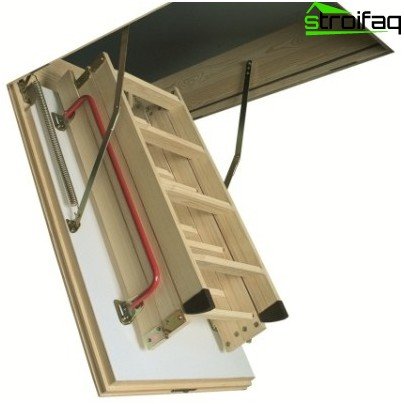
The staircase mounted on the roof of the attic is compact and hides in the ceiling after use.
Important! An attic hatch with a staircase must be insulated, since the probability of heat loss through it is quite high. In addition, installing a lock on the hatch so that outsiders cannot get into the attic from the house or into the house from the attic is not an extra precaution.
Features of installation technology
It happens that not one of the options offered by manufacturers according to one or another characteristic suits the owner and then the only way out of the situation is to independently install the attic staircase, but it will be exactly as needed.
In fact, an attic staircase with your own hands is not such an impossible task for a person who has certain building skills. When calculating the stairs, you need to consider:
- distance between steps: a large distance between steps will significantly complicate climbing stairs, too small will make it not only uncomfortable, but also dangerous;
- the strength of the side and vertical beams, on which depends what load the ladder can withstand;
- the angle at which the staircase will be installed (the optimum angle is 60-75 degrees). With an increase in the angle of inclination, the staircase will cease to be convenient and safe, with a decrease, it will take up much more space and may not fit into the space allotted to it.
In order for the installation of the attic stairs to go quickly and without misunderstanding, you need to prepare the necessary tools and materials:
- special mounting foam;
- good proven goniometer;
- set of wrenches;
- hacksaw;
- set of screws;
- screwdriver.
The staircase to the attic with your own hands must meet certain requirements and this must be remembered during operation, since the safety of its operation depends on the implementation of these standards, and in the event of its breakdown there will be no one to blame, except for yourself. So, the stairs to the attic, made by yourself, should be:
- strong and safe. If possible, it would be nice to equip it with additional handrails, railings and anti-slip pads on the steps;
- convenient and easy to use, so that it can be used by all those who have a good reason to go to the attic (the exception is small children who have nothing to do in the attic without adults);
- ergonomic and compact, otherwise you can simply install a stationary staircase and not waste time and effort on a useless and bulky design;
- fireproof. This moment is often overlooked when assembling wooden stairs.
Folding, they are folding attic stairs have another important characteristic: their design allows you to add or remove sections depending on the height of the room, which is quite difficult to do with an already installed stationary staircase.
For absolute and unconditional comfort, an attic staircase with an electric drive is ideal, which is controlled by a remote control or a special button on the switch. In addition, such stairs are usually made of metal, which significantly increases their fire resistance..
Taking into account all factors and a balanced approach to choosing the type of attic stairs, its installation will not be very difficult.



